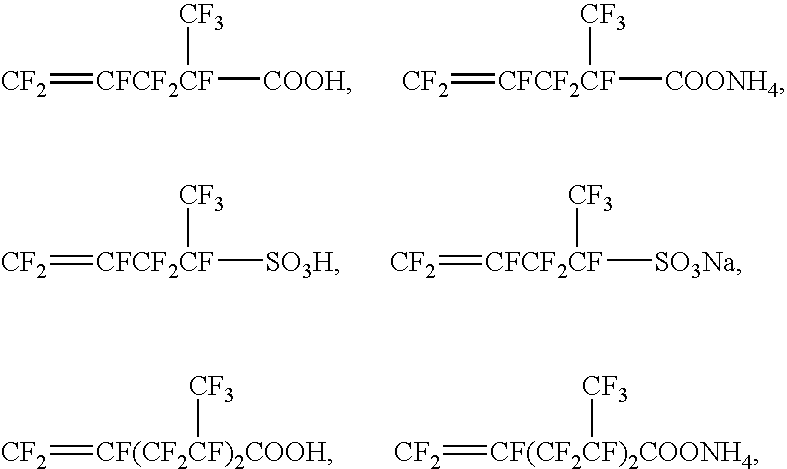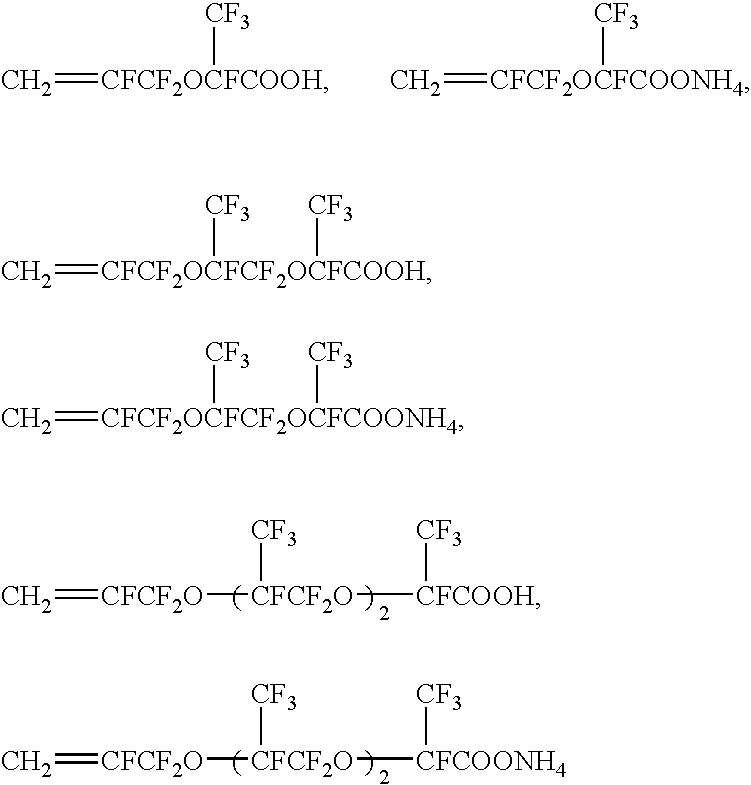Method for producing fluorine-containing elastomer polymer
- Summary
- Abstract
- Description
- Claims
- Application Information
AI Technical Summary
Benefits of technology
Problems solved by technology
Method used
Image
Examples
example 1
First Polymerization Step Using RS-1
[0240] A 3-liter stainless steel pressure vessel equipped with a stirrer was charged with 1200 ml of deionized water and 1.2 g of ammonium perfluoro(9,9-dihydro-2,5-bistrifluoromethyl-3,6-dioxa)-8-nonenoate [RS-1] as a vinyl group-containing fluorinated emulsifier and, after repeated pressurization with nitrogen and vacuum degassing, a fluoromonomer mixture composed of VDF / HFP=65 / 35 mole percent (hereinafter such fluoromonomer mixture is referred to as “mixed monomer”) was introduced into the vessel under reduced pressure of −700 mmHg to thereby raise the pressure to 0.85 MPa at 80° C. Upon addition of 12 g of a 2% (by mass) aqueous solution of ammonium persulfate, the pressure was found to fall. Therefore, after a pressure falls to 0.75 MPa, a mixed monomer composed of VDF / HFP=78 / 22 mole percent was introduced to restore the pressure of 0.85 MPa.
[0241] Thereafter, while repeating this procedure, the reaction was continued for 4.2 hours to give ...
example 2
First Polymerization Step Using RS-2 [AEC-0]
[0243] An aqueous emulsion (1427 g) was obtained in the same manner as in Example 1 except that 0.7 g of ammonium perfluoro(6,6-dihydro-2-trifluoromethyl-3-oxa)-5-hexenoate [RS-2] was used as the vinyl group-containing fluorinated emulsifier and that the polymerization was carried out for 3.9 hours. This aqueous emulsion had a solid matter concentration of 14.9% by mass, and the average particle diameter was 28.3 nm. The number of polymer particles was 8.20×1015 per cm3 of the water used in the polymerization.
[0244] The washed and dried coagulation product obtained by coagulation, washing and drying in the same manner as in Example 1 had a composition of VDF / HFP / RS-2=80.7 / 19.2 / 0.1 mole percent (63.9 / 35.6 / 0.5% by mass), and the unreacted RS-2 content was below the detection limit.
example 3
First Polymerization Step Using RS-3 [CBVE]
[0245] An aqueous emulsion (1591 g) was obtained in the same manner as in Example 1 except that 1.2 g of ammonium perfluoro(5-trifluoromethyl-4,7-dioxa)-8-nonenoate [RS-3] was used as the vinyl group-containing fluorinated emulsifier and that the polymerization was carried out for 4 hours. This aqueous emulsion had a solid matter concentration of 13.9% by mass, and the average particle diameter was 24 nm. The number of polymer particles was 1.24×1016 per cm3 of the water used in the polymerization.
[0246] The washed and dried coagulation product obtained by coagulation, washing and drying in the same manner as in Example 1 had a composition of VDF / HFP / RS-3=77.3 / 22.6 / 0.1 mole percent (59.3 / 40.4 / 0.3% by mass), and the unreacted RS-3 content was 362 ppm.
PUM
| Property | Measurement | Unit |
|---|---|---|
| Fraction | aaaaa | aaaaa |
| Fraction | aaaaa | aaaaa |
| Percent by mass | aaaaa | aaaaa |
Abstract
Description
Claims
Application Information
 Login to View More
Login to View More - R&D
- Intellectual Property
- Life Sciences
- Materials
- Tech Scout
- Unparalleled Data Quality
- Higher Quality Content
- 60% Fewer Hallucinations
Browse by: Latest US Patents, China's latest patents, Technical Efficacy Thesaurus, Application Domain, Technology Topic, Popular Technical Reports.
© 2025 PatSnap. All rights reserved.Legal|Privacy policy|Modern Slavery Act Transparency Statement|Sitemap|About US| Contact US: help@patsnap.com



